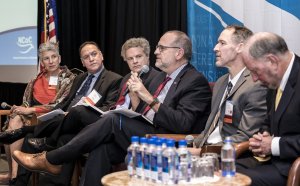My Civic Engagement Conundrum
Every day, I am presented with incredible stories about civic engagement, voluntarism, financial generosity and passion for community. Every day, I get to interact with people who make our communities the best they can be, by working for great arts programs, a clean environment, shelter for the homeless, great education, inclusion, and an end to the opportunity gap.
Yet I also know the numbers tell us that civil society in America is shrinking. We Americans simply aren’t involved as much as we used to be. Volunteering rates are down, giving rates are down, and we trust each other less and less. And I hardly need to say that the partisan divide has become fiercer than ever.
By the numbers, we’re less engaged and more divided. Yet the evidence of commitment are everywhere.
That’s my conundrum.
So I was pleased to join a panel at the National Conference on Citizenship annual meeting last month, addressing these very questions. Why are participation levels down? And more to the point, who is doing  good work to address the downturn? And what should we do going forward?
good work to address the downturn? And what should we do going forward?
Harvard Political Scientist Robert Putnam (author of Bowling Alone and Our Kids among others) shared data about the problems, and then a small panel of us (foundation and nonprofit leaders from across the country – I’ve listed the names below) discussed what we’re seeing. And there’s much to see. From programs to engage young people in philanthropy or model governments, to programs training communities in how to engage in grassroots democracy, there’s much to be excited about.
At the same time, Putnam and civic entrepreneur John Bridgeland published an op-ed in which they called for big ideas to revive civil society and bridge our divides, including:
– Universal national service, an opportunity for every 18-28 year old to perform at least a year of civilian service;
– Engaging philanthropy in a $1 billion annual campaign to restore American history and civic education to its rightful place in American schools.
I’ve long been a fan of shared national service, and I’m also a fan of expanded civic education. On that note, thanks to Senator Chris Coons, who last week co-sponsored introduction of the America’s Call to Improve Opportunities Now (ACTION) for National Service Act, which would increase opportunities for service across the country and provide young Americans with the chance to select a service program in a variety of fields. In exchange for their national service, students would get help paying for college.
And there’s so much more. At the DCF, we support the NextGen programs to encourage 20- and 30-somethings to engage in philanthropy. We support the Youth Philanthropy boards to teach high school students about giving back. And there are scores of other programs doing similar education, and providing similar opportunities.
They all matter, and they are projects that we need. We are living in this conundrum. Participation is down, but more of us are working to change that.
I choose to look at this problem as an opportunity. I choose to celebrate and encourage any program that encourages more engagement. And at the DCF, we are going to keep looking for programs to expand engagement, and bring people together.
And if you have ideas about how to bring people back to the civic space, and to bridge the divides, drop me a line. I’d love to talk.
* * *
For more about the issues I discuss here, I highly recommend NCOC’s new report “Civic Deserts: America’s Civic Health Challenge,” and Robert Putnam and John Bridgeland’s opinion piece “America needs big ideas to heal our divides.”
In case you’re interested, my fellow panelists included (in the order shown in the photo above): Diane Douglas of the Seattle City Club, Valeriano Ramos from Everyday Democracy, John Bridgeland from Civic Enterprises, me, Shawn Healy of the Robert McCormick Foundation, and Robert Putnam,